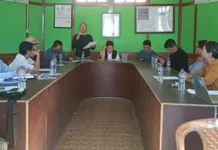[ Aloka Mili ]
On the eve of the International Mother Language Day, 21 February, let’s take a quick look around and see where we stand. Today tribal and minor languages all over the world have reached a point of crisis. Very few children are learning their mother tongue in the traditional way- from their parents and elders. Even when the parents speak the mother tongue, they do not often pass it on to their children.
In several communities, mother languages are used only by the elders. Most languages spoken by small communities have thus become endangered, because successive generations of speakers are becoming multilingual and losing proficiency in their mother language. Some have even vanished. The oral and written literary wealth they had also disappeared or have been confined to research shelves or museums. Our Arunachali languages are a typical example. Today most Arunachali households have become very comfortable in communicating in other tongues. Rather, most of our day to day interactions take place in these languages.
Thus, our tribal languages are being displaced by socially, politically and economically dominant languages. This is not surprising, because these dominant languages are academic media; they open the doors to higher education and job opportunities.
What then is the future of our languages? Isn’t it an irony that in spite of seven decades of independence and over three decades of statehood, Arunachal has no Arunachali official language – Even when we have nearly 28 major tribal languages?
A question may arise in the mind of many: why should we be so fussy about our language? The answer emerges as we examine another question: What is the place of a language in the life of a community?
Languages are the foundation of a culture. When a language dies, so does the link to cultural and historical pasts of the people who speak it. Without this link with our mother tongue, people start losing their sense of identity and belonging. Every culture is a different world in itself. There are certain words and expressions which are unique to that culture. For example, we have a word ‘restless’ in English, but in Idu Mishmi, we don’t have a word, but a phrase ‘à sù Jàkàmi’ to express restlessness. We can get more examples from other languages as well. This proves that every language has its own unique way of expression, which is developed and has been passed on through generations.
Further, writing systems currently exist for only 1/3 rd of the world’s languages. So, spoken forms are the only way to communicate and convey a community’s songs, stories and poems. So what needs to be done to make such minor languages, like Arunachali languages grow and flourish?
A language can grow only when it produces new literary inputs. Hence, we in Arunachal must soon develop and accept wholeheartedly a script for our languages. With the emergence of computer and mobile, Roman script seems a ready and acceptable form for most Arunachal languages. Some new scripts like Tani script and the Wancho script have also been successfully developed, but these need to be actively popularised.
Youth and students can contribute a lot to promote written forms. We can start writing letters, articles, poems, short stories, etc and blog in our mother tongue. We must also bring out many books for general reading. And the youth could benefit by literary forms. At present, it is confined only to English and Hindi, and a few elderly stalwarts who write in Assamese.
Thus, it is a matter of great happiness that Gandhi’s biography for youth by Tulika Books was released on 2nd October, 2019 in Adi, Apatani, Miju Mishmi (Kaman), Nocte, Nyishi and Bodo languages. Similarly in December 2020, two E-books in Idu language were brought out by IMCLS, from Pratham Book’s website www.storyWeaver.org. An E-dictionary of common Idu vocabulary has also been released and is getting very popular. ‘Idu Ajobra’, an Instagram page is a good example of how a social media platform can be used for creating awareness among today’s youth using modern tools.
Fortunately, the New Education Policy has introduced teaching mother language mandatory in primary classes 1 to 3. We in Arunachal must take full advantage of this new policy. Today, technology has made it easy to bring out several child-friendly readers for promoting joy of reading. Such readers in mother tongue would greatly create enthusiasm in the community to learn and teach mother tongue.
Mastering the mother tongue at an early age has one more benefit. It is universally accepted that those proficient in their mother tongues can learn other languages much easily.
Let us help our children develop a strong love for their mother tongue. It is the responsibility of parents to transmit the oral knowledge to the next generation because the knowledge transmitted today will become the cornerstone of tomorrow’s society. Our government and the elders of the society should lead today’s generation to the right path for the revitalization of our cultures. The best way to preserve our language is to keep it alive, by speaking, reading and writing. (Aloka Mili is an MA student at the Rajiv Gandhi University, Doimukh and an active volunteer of the Dibang Youth Library, Roing. She can be reached at alokamili999@gmail.com )




